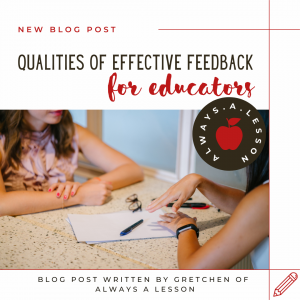Feedback is an opportunity for growth whereas effective feedback is the roadmap for getting there.
As educators, we want to continue to hone our craft by staying up-to-date on the latest best practices. We also want to know where we measure up in comparison to the expectation for our role. Seeking feedback helps us know what we are doing well and where we are missing the mark.
Surprisingly, educators are swimming in feedback and not all of it is effective. It may be confusing, unrelated or even outdated. Whether you are an educator seeking feedback or a teacher leader providing feedback to teachers, the following characteristics will enhance the type and method of feedback you're providing so that it translates to teacher success in the classroom.
Quick Feedback Format
When you are providing quick feedback to educators, you can follow the recipe below:
- What are they doing well? Praise for success. Although feedback seems to only be for – what to do better, first and foremost, it is to celebrate what is going well. Feel free to list as many as you can to boost confidence and encourage motivation to continue working.
- What improvements need to be made? Even though there might be growth, there are still areas to improve. Share one change to implement that will have the biggest impact on student learning.
- Are they on the right track? Be specific as to what they did and where that is in relation to the goal. Even if they did not reach the goal, if they made improvements in the right direction, it's worth noting.
- What is the overall performance? Take into consideration the strengths and weaknesses of the teacher's performance and provide a rating based on a rubric. This rubric should outline clear indicators of success along a continuum. (Need one? Use this one.)
Effective Feedback Characteristics
When you are not under time constraints, you can take the original feedback recipe above and expand on it. Here are elements to consider:
- Actionable– Provide next steps so educators know what they must do going forward
- Deepen understanding- Share background information or additional insight to help educators continue learning and growing their knowledge base
- Non-evaluative- For feedback to translate to implementation, ensure feedback is meant as suggestions instead of directives related to formal evaluation (ie. you can reference a rubric (ie."this is where you would have scored if this was an official observation"), but it should not actually count)
- Ongoing- One and done feedback is not enough touch points to support a learner so provide multiple opportunities for feedback as the educator applies feedback and tries again
- Opportunity to revise- For immediate implementation, build in time for educators to make revisions with you based on your feedback (and potentially receive follow-up feedback)
- Personalized- Avoid one-size-fits-all feedback and personalize it to an educator's personality, skillset, knowledge, etc.
- Related to learning goals- Tie feedback to what the learning goal is instead of choosing an area of focus that will not lead to success of meeting the learning target
- Specific- Providing clarity in who, what, where, when, why and how will allow educators to understand why your feedback is important and how to implement it
- Timely- For feedback to be helpful and relevant, follow-up with feedback immediately so educators can make changes without doing things ineffectively for too long
Feedback Resources
Add these resources to your feedback system for educators:
- Lesson Plan Feedback Template
- PD Feedback Survey
- Classroom Observation Feedback Slips
- Authentic, Actionable Feedback: Creating a Feedback System for Teachers Video
Looking for more great resources? Grab everything you need with this instructional coaching MEGA BUNDLE!
GO BE GREAT!

